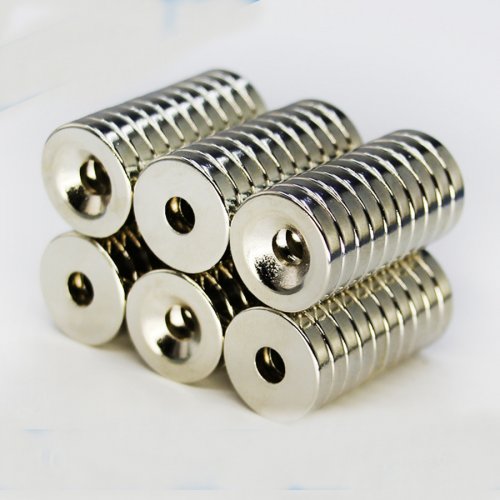Slater
Headphoneus Supremus
I apologize if this has been discussed before. I searched & could not find anything on the topic, but there's no way I'm the first to think of it.
Has anyone ever tried stacking additional neodymium magnets (with opposite poles touching to effectively create a more powerful magnet) on the driver of their headphones? It would be a cheap, easy, and reversible mod to perform.
According to this site (http://www.kjmagnetics.com/blog.asp?p=doubled-forces), adding a 2nd, identically-sized neodymium magnet results in a magnetic force increase of ~169% (not 2x, due to the layers of plating on the magnets causing a slight reduction).
What effect does it have on sound? According to Fostex, higher magnetic flux density improves attack and decay for a crisper, more detailed sound signature. Headphones like the TH-X00 use magnets that exceed 1 tesla (1 tesla = 10,000 gauss).
Obviously, one would have to accommodate appropriately for drivers that have vent holes in the magnet. And I know that manufacturers design the drivers and magnets to work together as one 'unit'. But that doesn't mean there aren't room for improvements. Cost certainly has a large influence on product design, and manufacturers usually don't just grossly overengineer everything. Why use 2x oversized magnets or plastic that's twice as thick/rigid when it can be engineered to be 'just good enough' but a whole lot cheaper?
==================================================
Update 01/22/2018 - Be sure to read through all of the posts in this thread possible, as lots of good discussion going on. As promised, I will be keeping this 1st post updated with a 'running database' of magnets that work on particular headphones. To have magnet/headphone data added to this post, follow the guidelines** below
** Database Guidelines:
Has anyone ever tried stacking additional neodymium magnets (with opposite poles touching to effectively create a more powerful magnet) on the driver of their headphones? It would be a cheap, easy, and reversible mod to perform.
According to this site (http://www.kjmagnetics.com/blog.asp?p=doubled-forces), adding a 2nd, identically-sized neodymium magnet results in a magnetic force increase of ~169% (not 2x, due to the layers of plating on the magnets causing a slight reduction).
What effect does it have on sound? According to Fostex, higher magnetic flux density improves attack and decay for a crisper, more detailed sound signature. Headphones like the TH-X00 use magnets that exceed 1 tesla (1 tesla = 10,000 gauss).
Obviously, one would have to accommodate appropriately for drivers that have vent holes in the magnet. And I know that manufacturers design the drivers and magnets to work together as one 'unit'. But that doesn't mean there aren't room for improvements. Cost certainly has a large influence on product design, and manufacturers usually don't just grossly overengineer everything. Why use 2x oversized magnets or plastic that's twice as thick/rigid when it can be engineered to be 'just good enough' but a whole lot cheaper?
==================================================
Update 01/22/2018 - Be sure to read through all of the posts in this thread possible, as lots of good discussion going on. As promised, I will be keeping this 1st post updated with a 'running database' of magnets that work on particular headphones. To have magnet/headphone data added to this post, follow the guidelines** below
- 1More MK801 - 20mm x 4mm round magnet (with hole)
- Edifier H840 - 20mm x 5mm round magnet (with hole)
- JVC HA-RX900 (placeholder)
- Meizu HD50 - 15mm x 4mm round magnet (with hole). Stock driver is 15mm, & has (1) vent hole in center
- Philips Fidelio X2/X2HR - 20mm x 5mm round magnet (with hole). Stock driver is 20mm, & has (1) vent hole in center
- Philips SHL3300 - (placeholder)
- Philips SHP9500 - 20mm x 7mm round magnet (with hole). Stock driver is 20mm, & has (1) vent hole in center
- ISK MDH9000 - 20mm x 7mm round magnet (with hole). Stock driver is 20mm, & has (1) vent hole in center
- Akai Project 50X - 20mm x 7mm round magnet (with hole). Stock driver is 20mm, & has (1) vent hole in center
- Marantz MPH-2 - 20mm x 7mm round magnet (with hole). Stock driver is 20mm, & has (1) vent hole in center
- LyxPro HAS-30 - 20mm x 7mm round magnet (with hole). Stock driver is 20mm, & has (1) vent hole in center
- Freeboss MDH9000 - 20mm x 7mm round magnet (with hole). Stock driver is 20mm, & has (1) vent hole in center
- Sivga SV007 - 20mm x 7mm round magnet (with hole). Stock driver is 20mm, & has (1) vent hole in center
- Sony MDR-ZX100 (placeholder)
- Sony MDR-ZX110 (placeholder)
- SoundMAGIC HP150 (placeholder)
- SoundMAGIC HP200 (placeholder)
- Superlux HD-660 (placeholder)
- 1More H1707 Triple Driver over-ears
- JBL J55
- Sennheiser Momentum v1 (over ear)
- Sennheiser HD 630VB
- Philips A5 Pro
** Database Guidelines:
- You must specify the diameter of the stock magnet. If the stock magnet has 2 or 4 vent holes, include the largest diameter magnet that will fit 100% inside of the vent holes (ie without obstructing the vent holes).
- You must specify the number and placement of the stock magnet vent holes (ie 1 vent in center, 4 vents in square pattern, 2 vents in straight line, etc).
- Please provide the maximum size magnet possible (not just "whatever works"). For example, the Fidelio X2 will accommodate a smaller magnet, but 20mm*5mm magnets are the same diameter as stock (and thus the largest diameter/most powerful magnet possible).
- Make sure you only list magnets that allow the cups to go back together without mods (it's not helpful to stack 6" of magnets on a driver if you can't put the headphones back together LOL).
- PM me the information and I will add it to the database.
Last edited:
























